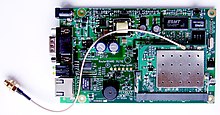Wireless access point
From Wikipedia, the free encyclopedia
Not to be confused with Wireless Application Protocol.
See also: Wireless router
| | This article needs additional citations for verification. Please help improve this article by adding citations to reliable sources. Unsourced material may be challenged and removed. (March 2010) |
Industrial grade WAPs are rugged, with a metal cover and a DIN rail mount. During operations they can tolerate a wider temperature range, high humidity and exposure to water, dust, and oil. Wireless security includes: WPA-PSK, WPA2, IEEE 802.1x/RADIUS, WDS, WEP, TKIP, and CCMP (AES) encryption. Unlike some home consumer models, industrial wireless access points can also act as a bridge, router, or a client.
[edit] Introduction
[edit] Common WAP applications
A typical corporate use involves attaching several WAPs to a wired network and then providing wireless access to the office LAN. The wireless access points are managed by a WLAN Controller which handles automatic adjustments to RF power, channels, authentication, and security. Further, controllers can be combined to form a wireless mobility group to allow inter-controller roaming. The controllers can be part of a mobility domain to allow clients access throughout large or regional office locations. This saves the clients time and administrators overhead because it can automatically re-associate or re-authenticate.A hotspot is a common public application of WAPs, where wireless clients can connect to the Internet without regard for the particular networks to which they have attached for the moment. The concept has become common in large cities, where a combination of coffeehouses, libraries, as well as privately owned open access points, allow clients to stay more or less continuously connected to the Internet, while moving around. A collection of connected hotspots can be referred to as a lily-pad network.
The majority of WAPs are used in Home wireless networks.[citation needed] Home networks generally have only one WAP to connect all the computers in a home. Most are wireless routers, meaning converged devices that include the WAP, a router, and, often, an ethernet switch. Many also include a broadband modem. In places where most homes have their own WAP within range of the neighbors' WAP, it's possible for technically savvy people to turn off their encryption and set up a wireless community network, creating an intra-city communication network although this does not negate the requirement for a wired network.
A WAP may also act as the network's arbitrator, negotiating when each nearby client device can transmit. However, the vast majority of currently installed IEEE 802.11 networks do not implement this, using a distributed pseudo-random algorithm called CSMA/CA instead.
[edit] Wireless access point vs. ad hoc network
Some people confuse Wireless Access Points with Wireless Ad Hoc networks. An Ad Hoc network uses a connection between two or more devices without using a wireless access point: the devices communicate directly when in range. An Ad Hoc network is used in situations such as a quick data exchange or a multiplayer LAN game because setup is easy and does not require an access point. Due to its peer-to-peer layout, Ad Hoc connections are similar to Bluetooth ones and are generally not recommended for a permanent installation.Internet access via Ad Hoc networks, using features like Windows' Internet Connection Sharing, may work well with a small number of devices that are close to each other, but Ad Hoc networks don't scale well. Internet traffic will converge to the nodes with direct internet connection, potentially congesting these nodes. For internet-enabled nodes, Access Points have a clear advantage, with the possibility of having multiple access points connected by a wired LAN.


Niciun comentariu:
Trimiteți un comentariu